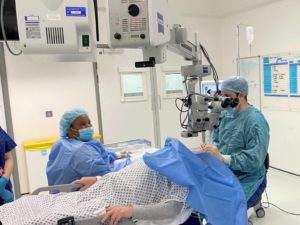Maximising Efficiency in Ophthalmology
 MKUH has launched a new High Volume Low Complexity (HVLC) cataract surgery list so that more patients can be treated over a shorter space of time.
MKUH has launched a new High Volume Low Complexity (HVLC) cataract surgery list so that more patients can be treated over a shorter space of time.
During a morning or afternoon of surgery, staff are now able to treat up to 10 patients – almost double the previous number. The new service is the result of detailed planning and is delivered by a multidisciplinary team of colleagues from theatres, ophthalmology, anaesthetics, our day surgery unit and our wider surgical operational units.
“It is an efficient way of ensuring we are able to treat more of our cataract patients in a shorter space of time, whilst still providing the highest quality of patient care,” explains theatres project manager Talia Lewis. “We have streamlined the whole process so that it runs very smoothly with a shorter time between patients. For example, the surgeon would have previously attended to paperwork as well as performing surgery, but that is now carried out by another doctor, freeing the surgeon up to focus solely on the cataract removal and placement of a new lens.
“Every member of staff is doing their job to a very high level and it is that kind of commitment that makes it possible for us to treat more patients in the same amount of time.”
Surgeon Mr Ammar Miri has been performing HVLC cataract surgery in the independent sector for some time.
“We started the HVLC cataract list here at MKUH in early March and I am pleased to say we are already as efficient,” he says.
The new process is designed as a Getting it Right First Time (GIRFT) approach to improving patient access to cataract surgery. The aim is to ensure patients have timely treatment, whilst also helping to clear the backlog of patients who have had long waits as a result of the pandemic.
Eight to ten patients are seen within each HVLC surgery list, with the average operation time just 10 minutes, with a five-minute turnaround in the theatre before the next patient is brought in.
Talia Lewis adds: “Organisation is key and every patient is accompanied to and from theatres with the same member of staff. This is great for both continuity but also to reassure any patient who might be worried or anxious about the procedure.
“It is a clear case of excellent teamwork. Everything is prepared and double-checked in advance, with staff very clear on what their role is going to be during the course of a list.”
Patients arrive at our Day Surgery Unit where our nursing teams ensure that all paperwork is completed and correct. Anaesthetic eye drops are administered to the eye to be operated on so that the procedure will be painless. Theatre staff prepare trays of sterile equipment for each individual patient. When the procedure is completed for one patient, they are escorted back to the day surgery unit for refreshments, and they are able to go home soon afterwards. The process is repeated until all patients have been treated.
One patient, Peter Green from Milton Keynes, was very pleased with the whole process.
“Everyone was reassuring and friendly. It was a very smooth process and the procedure was over in no time,” he says.
Melanie Pudol, theatre team leader for Theatre 5, where the operations were performed, adds: “It doesn’t feel like the patients are ever being rushed. They are still given the high quality of care and attention they deserve.”
Last Modified: 2:43pm 22/03/2023
For all media enquiries please contact [email protected]
